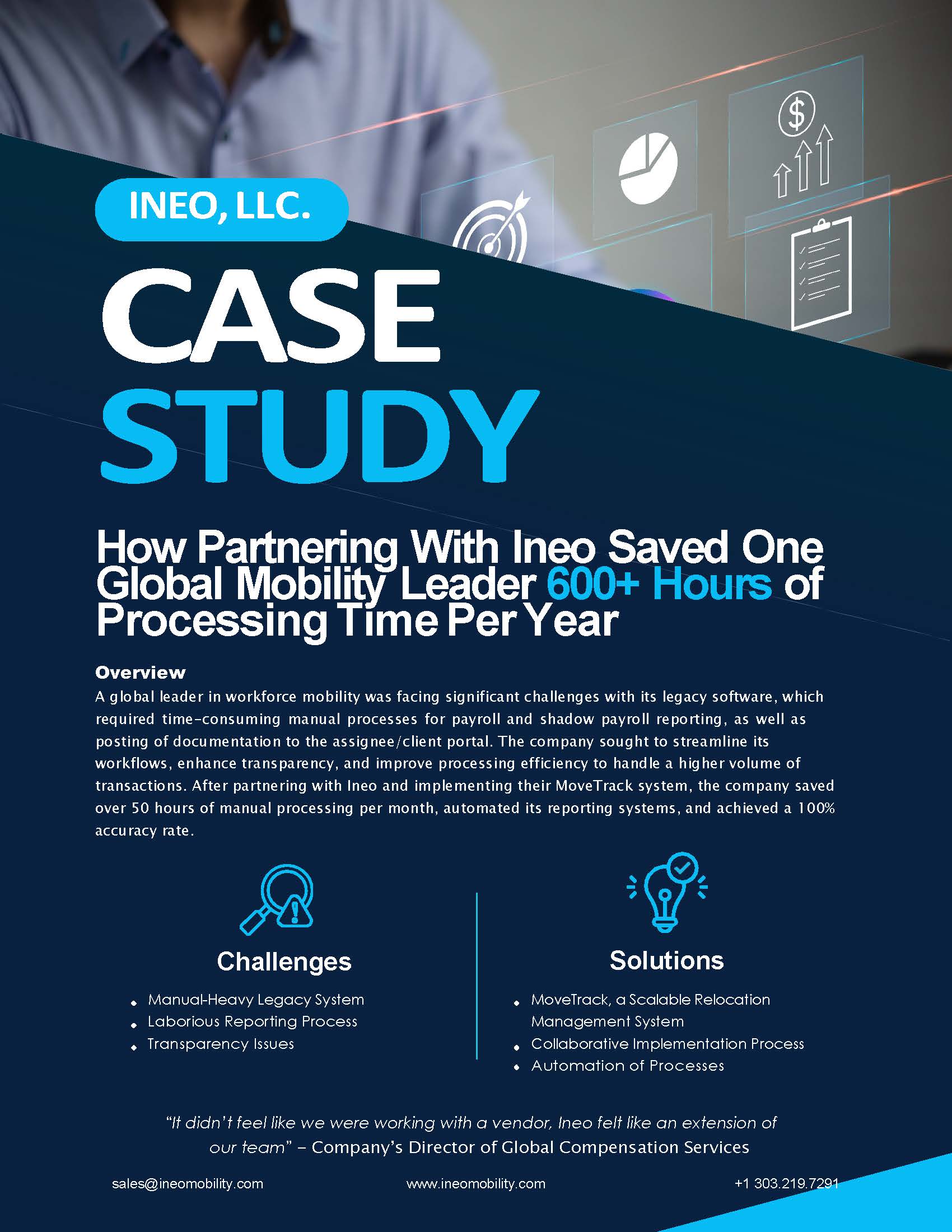A Quick Guide to Global Mobility Tax Terms: Part One

We’ve created a handy glossary of frequently used global mobility tax terms to demystify some of the complex terminologies in our industry.
We’ll be the first to admit that tax terminology can be confusing. We know that throwing global mobility tax terms into the already dizzying mix of tax nomenclature is enough to make someone go cross-eyed. Tax terms are plentiful, situationally specific, and frequently evolving.
Ineo didn’t build this tax lingo maze, but we’re happy to guide you through it with part one of a handy two-part glossary.
Ten Frequently Used Global Mobility Tax Terms
1. Adjusted Gross Income
Adjusted gross income (AGI) is an intermediate figure between gross income and taxable income. Simply put, AGI is the sum of your total gross income, minus adjustments and deductions.
2. Closing Disclosure Statement
A closing disclosure statement is a form that describes important financial conditions of purchasing or selling a home. This includes information such as the purchase price, property details, closing costs, and estimated real-estate taxes. Closing disclosure statements are received when both purchasing and selling a home, and contain details that are essential in filing taxes.
3. Depreciation
Depreciation is an allotted allowance that a homeowner can claim for deduction in order to compensate for the loss of value in a property used for business or income generation, such as a rental property.
There are limits to what costs are eligible for depreciation, including the value of the land where the property resides.
4. Distance Test
A distance test is how the IRS determines if your relocation expenses qualify for a deduction. To deduct job-related moving expenses, transferees must meet the qualifications of the distance test. The distance from your old home to your new place of business must be, at minimum, 50 miles farther than the distance from your old home to your old place of business.
For example: Before relocating, your commute from your house to your office was 5 miles. After relocating, your new office is 55 miles away from your old home. Because you are traveling 50 miles farther than your previous commute, you’re able to deduct your relocation moving expenses. In most states, moving expenses are not deductible for Federal Tax purposes, unless you’re a member of the U.S. Armed Forces. State exceptions are AR, CA, HI, MA, NJ, NY, and PA.
5. Domicile
According to tax laws, a domicile is a person’s legal home located in the state to which they contribute income taxes. A domicile may be a house, an apartment, or a non-traditional living situation, such as a co-op.
Though you might own multiple properties or travel between homes, all taxpayers are considered to only have a single domicile at any time. Any other housing situations are considered residences.
If a taxpayer travels between two separate properties and spends successive periods in each, the property the taxpayer occupies for the majority will be considered their principal domicile. This means that even if your assignment requires you to reside in one state, your domicile may be located in another.
6. Exemption
In regards to taxes, exemptions refer to income or transactions that are not subject to taxation. Tax exemption may partially or completely reduce a person or organization’s taxable income. Examples of non-taxable exemption income include alimony, child support, and eligible worker’s compensation.
Federal income tax exemptions are standard across the U.S., but the determination and value of state exemptions vary from state to state.
7. Expatriate
An expatriate is someone who resides overseas but continues to hold citizenship in their country of origin. The term expatriate, or “ex-pat”, is especially relevant in global mobility programs as many transferees on overseas assignments fall into this category.
If an expatriate maintains U.S. citizenship, they’re obligated to continue paying federal taxes, regardless of overseas residency. While abroad, transferees may qualify for expatriate federal tax deductions.
8. Foreign National
A foreign national is an individual, company, or organization that is neither a citizen nor a national of the country of reference. For example, a citizen of Israel may be on a stateside assignment, but because they are an Israeli citizen and owe allegiance to Israel, they are considered a foreign national by U.S. law.
In the United States, any income a foreign national earns while stateside is subject to federal withholding taxes. Similarly, U.S. citizens or nationals who have transferred abroad and are earning income in a host country may be obligated to their host country’s tax codes.
Because the qualifications for both expatriate and foreign national deductions are complex, it’s recommended to partner with global mobility tax professionals.
9. Gross-up
In global mobility programs, a gross-up is an additional payment made by an employer to offset the taxes a transferee will owe on non-deductible relocation expense reimbursements.
Because moving expenses are no longer tax-deductible, an employer may offer to reimburse a transferee’s relocation costs. In the eyes of the IRS, the reimbursement would be considered additional income. Because this income is taxable, the company would offer a gross-up to compensate for the taxes the employee would accrue on the relocation reimbursement payment.
There’s nothing particularly gross about gross-ups — if anything, offering a gross-up on relocation benefits is a recommended practice for global mobility programs, as it enhances a transferee’s experience.
10. Government Moves
Government moves are defined under Chapter 302 of the Code Section of Federal Travel Regulations (FTR). This chapter is a relaxing poolside read, clocking in at a weighty 84 pages. It covers essential topics such as: how relocation, moving, and permanent change of station expenses should be treated and calculating relocation income tax allowance payments.
Though it may be a dry read, Chapter 302 of the FTR is an invaluable resource for navigating government taxes.
Confusion shouldn’t be part of the global mobility tax equation
Understanding global mobility taxes sometimes requires breaking the terminology into bite-sized, digestible pieces. Our glossary is meant to empower you to interpret tax vernacular, but we understand some tax questions might require professional input. If you have unanswered questions about global mobility taxes, contact our industry experts. A part two of our global mobility tax terms will be available soon.
Global Mobility Resources
Learn more about what’s going on at Ineo and insights into the complex world of global mobility from the industry’s top thought leaders and innovators.
Request A Demo
Whether you are new to the world of global mobility or you’ve been in the business for a while, Ineo is here to assist you.
The best way to learn how Ineo’s global mobility software can help your company revolutionize your global mobility program and support your business strategy is to see it in a demo.
Fill out this form to get started today.
Get Started

 Click to Purchase
Click to Purchase




